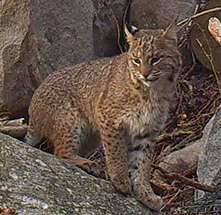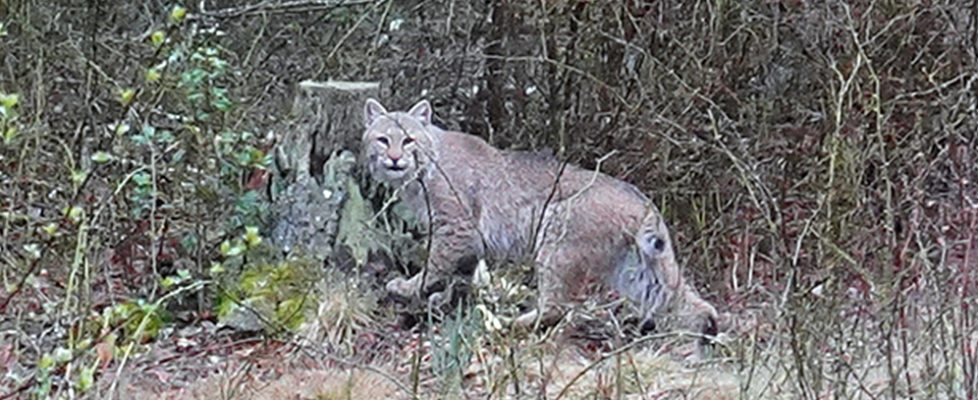Ruth Platner: Bobcats In Charlestown
When we shared the photo above of a bobcat, taken by my husband Cliff Vanover on April 22 in northeast Charlestown, to the CCA Facebook page, it created tremendous interest and was shared to thousands more people. From some of the Facebook comments it seemed that a few people may have confused bobcats with mountain lions. They are very different species and there are big differences between them.
Bobcats
- About 30 inches long and weigh between 15 to 30 pounds.
- A short bobtail that’s about five inches long.
- Tufted ears, where hair sticks up from the top of the ear.
- A tan or light orange-brown color with black spots.
- Eat small creatures such as rabbits and rodents, and occasionally chickens if they have the opportunity.
Mountain lions
- Typically 52 to 54 inches long and weigh between 100 and 175 pounds.
- Have a long, cylindrical tail with a dark tip. The tail is usually 30 to 36 inches long.
- Uniform in color and have a tawny coloration (a tan Orangish-Brownish Color).
- Mountain lions can eat deer or smaller animals.
Although a few people over the years have reported sighting mountain lions in Rhode Island, the Rhode Island Department of Environmental Management (DEM) doesn’t provide any information about them and treats these reports as unverified. Some of the people making the reports do know the difference between bobcats and mountain lions so there have been mountain lions at least passing through rural Rhode Island from time to time. Mountain lions have huge territories, so a sighting in different areas may be the same individual animal. Most, but not all, of the mountain lion reports are probably mistaken bobcat sightings.
As recently as 1998 bobcats were very rare in Rhode Island. In July of 1998 when a bobcat was hit and killed by a car in Exeter it created a sensation and DEM had the animal preserved and mounted by a taxidermist to be displayed at area museums and circulated at educational forums.

In 2017, URI Research Associate Amy Mayer reported that bobcat numbers appeared to be on the rise in our region, based on reported sightings and road killed animals collected since 2007. Based on the sighting reports in her research, she did not think they were densely populated in the state, but that there are pockets where they seem to be common.
Even if bobcats are becoming more common in parts of Charlestown, they are still elusive. Bobcats seldom venture out during daylight hours. You are most likely to catch a glimpse of them at dusk and dawn when they are most active. In the spring however you may see a mother out hunting for her young kittens in daytime.
Threats to bobcats include development, habitat encroachment, off road vehicles, trail bikes and snowmobiles, and of course cars and trucks in areas where bobcats need to cross roads. Coyotes compete with bobcats for territory, pushing them to the fringes of the remaining habitat. Bobcats are protected under Rhode Island state law, but protecting their habitat is the only way to secure their future.

You can learn more about the author, Ruth Platner, at her profile page.

April 30, 2019 @ 4:00 pm
Thanks Ruth
April 30, 2019 @ 11:52 am
Hi Ruth and many thanks for this article. Are the lengths that you give from nose to far end of tail or from nose to beginning of tail (or butt)? John
April 30, 2019 @ 12:03 pm
The lengths are from the head to the base of the tail (not the tip), so they do not include the tail length.